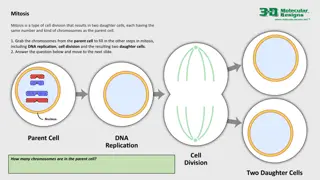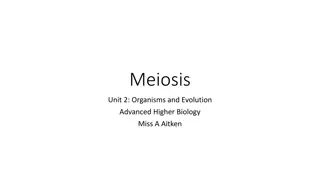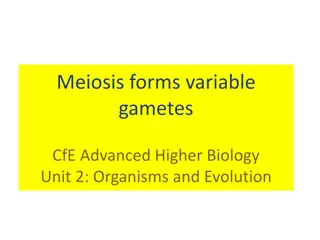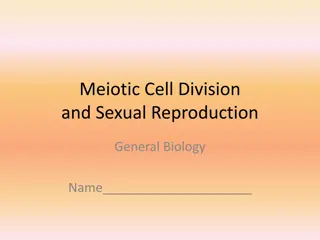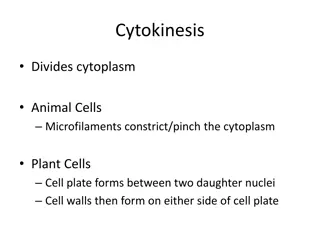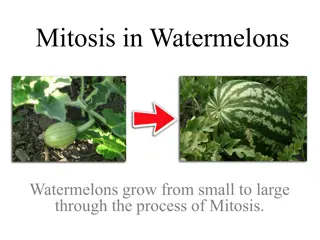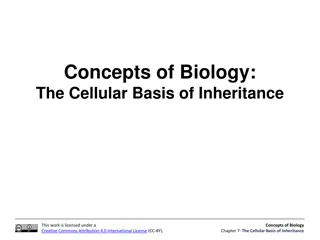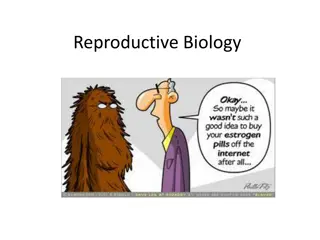
Meiosis: The Key Process in Gamete Formation
Dive into the intricate process of meiosis, where genetic material is halved to form haploid gametes like eggs and sperm. Explore the significance of crossing over and how homologous chromosomes play a crucial role in creating genetic diversity.
Download Presentation

Please find below an Image/Link to download the presentation.
The content on the website is provided AS IS for your information and personal use only. It may not be sold, licensed, or shared on other websites without obtaining consent from the author. If you encounter any issues during the download, it is possible that the publisher has removed the file from their server.
You are allowed to download the files provided on this website for personal or commercial use, subject to the condition that they are used lawfully. All files are the property of their respective owners.
The content on the website is provided AS IS for your information and personal use only. It may not be sold, licensed, or shared on other websites without obtaining consent from the author.
E N D
Presentation Transcript
Meiosis The formation of gametes (sex cells)
Some Vocab Haploid (n): one set of chromosomes Reproductive cells are haploid (23 Chromosomes in humans) Eggs Sperm Diploid (2n): two sets of chromosomes You are diploid ( 46 chromosomes in humans) 1 set from mom 1 set from dad
Some Vocab Homologous Chromosomes: two chromosomes with the same gene sequence as another, one from each parent.
What is Meiosis? Meiosis is a process of reduction division in which the number of chromosomes per cell is cut in half.
What is Meiosis? Meiosis involves two divisions Meiosis I Meiosis II
Meiosis I Interphase I DNA replicates Prophase I Crossing over occurs Metaphase I Chromosomes line up Anaphase I Chromosomes are pulled apart Telophase I/Cytokinesis Nuclear membranes forms. The cell separates into two cells.
What is Crossing Over? Crossing over is when two homologous chromosomes pair up and exchange segments of their genetic material. Crossing over results in genetic recombination. Crossing over is what makes every egg and sperm cell unique. Crossing over is why you are not exactly like your siblings.
Meiosis II Very similar to mitosis FINAL PRODUCT = 4 genetically different HAPLOID DAUGHTER CELLS
Meiosis II Prophase II Prophase II Metaphase II The chromosomes line up in a similar way to the metaphase stage of mitosis. Metaphase II Anaphase II The sister chromatids separate and move toward opposite ends of the cell. Anaphase II Telophase II Meiosis II results in four haploid (N) daughter cells. Telophase II Meiosis I results in two haploid (N) daughter cells, each with half the number of chromosomes as the original.
Meiosis II Prophase II Prophase II Metaphase II The chromosomes line up in a similar way to the metaphase stage of mitosis. Metaphase II Anaphase II The sister chromatids separate and move toward opposite ends of the cell. Anaphase II Telophase II Meiosis II results in four haploid (N) daughter cells. Telophase II Meiosis I results in two haploid (N) daughter cells, each with half the number of chromosomes as the original.
Meiosis II Prophase II Prophase II Metaphase II The chromosomes line up in a similar way to the metaphase stage of mitosis. Metaphase II Anaphase II The sister chromatids separate and move toward opposite ends of the cell. Anaphase II Telophase II Meiosis II results in four haploid (N) daughter cells. Telophase II Meiosis I results in two haploid (N) daughter cells, each with half the number of chromosomes as the original.
Meiosis II Prophase II Prophase II Metaphase II The chromosomes line up in a similar way to the metaphase stage of mitosis. Metaphase II Anaphase II The sister chromatids separate and move toward opposite ends of the cell. Anaphase II Telophase II Meiosis II results in four haploid (N) daughter cells. Telophase II Meiosis I results in two haploid (N) daughter cells, each with half the number of chromosomes as the original.
Gamete Formation Males In male animals, the haploid gametes produced in meiosis are called sperm. Females In female animals, one cell receives most of the cytoplasm and will become an egg cell. The other three cells produced are known as polar bodies and do not participate in reproduction.
Gamete Formation Males Spermatogenesis Females Oogenesis
Meiosis Mitosis To produce gametes (sex / gametic cells) Production of body cells (somatic cells) Purpose What kind of cells are produced? # of divisions required 2 1 1 1 # of cells needed to begin # of daughter cells produced 4 2 Half the number of the parent cell (n) The same number as the parent cell (2n) # of chromosomes in daughter cells (n/2n) # of chromosomes in daughter cells in humans 23 46 No Yes Are the daughter cells identical to the parent cell? Yes No Does crossing over occur?


